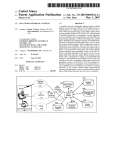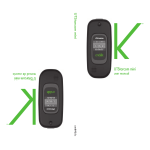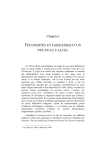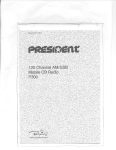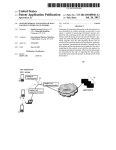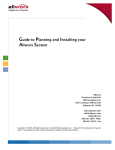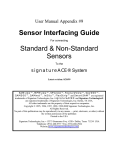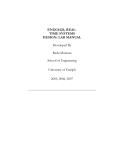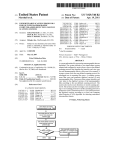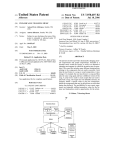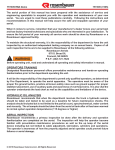Download PHONE CELLULAR NETWORK
Transcript
US 20070047707A1 (19) United States (12) Patent Application Publication (10) Pub. No.: US 2007/0047707 A1 (43) Pub. Date: Mayer et al. (54) IP-ENHANCED CELLULAR SERVICES (75) Inventors: Daniel J. Mayer, Warren, NJ (US); Alan V. Staniforth, East Brunswick, NJ (Us) (57) Mar. 1, 2007 ABSTRACT A federation of multinational PSTN, IP and cellular service providers coordinate their accounting by: populating a sub scriber database of subscribers to one number services, a service providers database and a payments clearing database Correspondence Address: DAVIDSON BERQUIST JACKSON & GOWDEY LLP 4300 WILSON BLVD., 7TH FLOOR ARLINGTON, VA 22203 (US) (73) Assignee: NET2PHONE, INC., Newark, NJ (21) Appl. No.: 11/211,644 (22) Filed: Aug. 26, 2005 Publication Classi?cation having amounts owed across the service providers based on the individual service provider’s portion of pre-agreed pay ments for services; collecting accounting data from the service providers; updating the relevant databases with the data collected; and providing accounting data to the service providers and subscribers. Voice over IP service is applied to a cellular phone by selecting a compatible codec at periph eral gateways of IP network paths, thereby avoiding transcoding by a connecting multimedia terminal adapter. A portable module, multimedia terminal adapter cellular inter net protocol gateway for media communications over an IP network (MTAC IPG) bridges a cellular network, an IP network and a PSTN so that a user may locally dial a cellular (51) (52) Int. Cl. H04M 15/00 phone that is then used to enter the IP network and dial the (2006.01) US. Cl. ..................................... .. 379/114.28; 379/111 called party. The MTAC IPG provides gateway functionality and packetiZing. l l l l l l l l l CELLULAR NETWORK 103 PLAIN PHONE l a Patent Application Publication Mar. 1, 2007 Sheet 1 0f 12 F '- | . T It‘ '- I T f - - - - - T T T T T T - T ' T - - - - ' 107 I CELLULAR ;'I PHONE I ‘I ; 101 PLAIN PHONE i i 1 l- l ‘I = - T T T T T T T T T T ' ' T T T I‘ CELLULAR Il PHONEv NETWORK I-‘ :I 209 CRADLE CPG 1 '. I. I 105 MTA | I I " ' I | . I‘ i lI - i 307 CELLULAR <<—l— T T " I 1. CELLULAR NETWORK : . I, I I‘ I‘ 115 IP NETWORK .l '. : l I PLNN 103 FIGURE 2 ; PHONE .| ,l 110 CELLULAR ‘. ‘. NETWORK I PHONE ' 1'‘ s05 ‘. I NITAC i i 1 CRADLE I 10s PLAIN T PHONE FIGURE 1 i1 1'. .l ' I 201 PLAIN ‘. ; T I iI 1 T | I I l I. T CELLULAR NETWORK PHONE PigilaN - 207 I 1 MTA \ :' 1 1 ‘I ‘I ', ; 1 105 ; i - US 2007/0047707 Al '. 115 IP NETWORK PHONE FIGURE 3 s00 SUBSCRIBER ENVIRONMENT i : 1 ; 1 45 Payments 440 So? Switch & ' cleanng AAA Subscriber Accounts Gateway$ subscriber PPP (Pro?le. Preferences. Service Platform Geographic Messaging Platform Association - Presence) Service Providers Patent Application Publication Mar. 1, 2007 Sheet 3 0f 12 T _ CELLULAR US 2007/0047707 A1 307 C‘PlR-GJRAR i'iQL'L PLUG PLUGE _______ C A B PLUG 305 MTAC CRADLE E FIGURE 5A lili 305 MTAC CRADLE ________ PLUG 307 PLUG 305 MTAC CRADLE FIGURE 55 I» CELLULAR << PHONE FIGURE 50 PLUG 307 305 CELLULAR PHONE MTAC CRADLE PLUG 1 FIGURE 6 Patent Application Publication Mar. 1, 2007 Sheet 4 0f 12 Plug MTAC Cradle wlcell-phone into Broadband source; Update presence in Register Cradle with its SlP Proxy Obtain IP Address from local ISP Cell-phone in cradle matches local providerls) Subscriber PPP & Geographic Association US 2007/0047707 A1 Pick participating cellular carrierls) at the new location Databases Program the cell phone's SIM card & trigger test call Update Subscriber Try Next PPP'. notify via cellular‘service MTAC Cradle provider Patent Application Publication Mar. 1, 2007 Sheet 5 0f 12 800 Start call Force lP 808 Force cellular MTAC Cradle 305 Ce" PhOne Presence; Network use signals off-hook & Network use User Preference dial string to cellular pho ne 307 Cradle 305 to Cellular session 810 Cellular session proceeds from plain 804 MTAC Cradle 305 uses dial-string to initiate SIP session via SlP proxies 425 Let Service Platform Choose Service Platform 435 signals MTAC telephone 103 FIGURE 8 801 User keys dial string into plain telephone 103 outgoing US 2007/0047707 A1 MTAC Cradle 305 signals dial string to service platform 435 with “Choose Best Network“ 806 Service Platform 435 signals MTAC Cradle 305 to initiate lP session lP-Network session Choose cellular Network Service Platform 435 selects best network based in part on preferences in Subscriber PPP 450 Upon session completion, store billing record in AAA subscriber Accounts 440, update payments clearing as needed. proceeds from plain telephone 103 Patent Application Publication Mar. 1, 2007 Sheet 6 0f 12 Enter dial string on the cellular phone's keypad Redirect dialed string through Service Platform 435 Consult the subscriber's PPP Database and Account Balance & Select Terminating Network Terminate call through the Begin Session Terminate cell through PSTN 120 or IP 115 networ k cellular network Periodically draw down on the real time account balance in PPP 450 Update AAA Disconnect Subscriber Session accunts 44 US 2007/0047707 A1 Patent Application Publication Mar. 1, 2007 Sheet 7 0f 12 I US 2007/0047707 A1 1°00 Fig 10 Call arrlves for - subscriber's one number ‘& 1002 SS6 430 feeds call parameters to Service Platform 435 1006 1008 Route to MTA 305 via Ring subscriber's IP Network 115 plain phone 103 _____________________________ _ J 1010 Route to plain phone 103 via PSTN 120 Service 435 routes Platform the 1012 Ring subscriber's plain phone 103 4 """"""""""""""" ' ' incoming calls by comparing call parameters to Subscriber PPP & Route 1014 can phone 307 ‘"2 @‘Ma' K 0 1016 Ring subscriber's cell phone 307 ______________________________ _ _Y Re-routes unsuccessful attempts based on the Subscriber PPP Rouf‘e ‘0 ‘1th?’ subscriber-speci?ed Ring follow-me device dev'ces ______________________________ "Y 1024 Intentionally do not answer w/signaling Route to Messaging Platform Modify session initiation Switch to lPG Mode per subscriber input Subscriber calls cellphone 307 from any external plain or cell phone MTAC lPG Authenticates caller. provides 2"d dial tone. & collects dialed string During the session, the MTAC lPG o encodes/decodes media between the cellular phone and the IP network; 0 packetizesldepacketizes media streams as needed. At session termination the MTAC IPG updates AAA Subscriber accounts 440 and payments clearing 445 pp 0 9 S 122D CELLULAR PHONE CR mmmm GATEWAY FUNCTlONAUTY 1220 CELLULAR PHONE GATEWAY FUNCT\ONAL\TY FIGURE 13 1220 CELLULAR PHONE 307 CELLULAR GATEWAY FUNCTIONALITY DSL MODEM Patent A ' ' ' pp l'lcatlon Publlcatlon Mar. 1, 2007 Sheet 10 0f 12 US 2007/004 7707 A1 FIGURE 15 |----- 110 425, 430, 435, 440, 445, 450, 455, 460, 465 OF FIGURE 4 [T3 CELLULAR I 0O SUBSCRIBER ENVIRONMENT N \NO ' 425, 430 , 435, 440 445, 450, 455, 460 , 465 OF FIGURE 4 s05 MTAC CRADLE IPG CELLULAR NETWORK SIP PROXIES SOFT SWITCH & GATEWAYS SERVICE PLATFORM SUBSCRIBER PPP AAA SUBSCRIBER ACCOUNTS PAYMENTS CLEARING PROVIDERS ' GEOGRAPHIC ASSOCIATION ____________‘_‘\‘_T_E_FI_I\IA_T_'9 MESSAGING PLATFORM NAL SERVICE FED ERATION l. P . . atent Appllcatlon Publication Mar . 1 , 2007 Sheet 11 0 f 12 US 2007/0047707 A1 CELLULAR PHONE (CODEC, ANALOGID\G\TAL ___________ 1 305 __ GWTTCH) I . WAC CELLULAR PHONE CRADLE 1 1 CRADLE (\NPUTIOUTPUT) ; ', | '. ‘. 1 ', ; Amiga \NLAN FOR PLATFORM FRONT-END(CONTROL, sER\/\CE sTORAGE, CODEC, . ‘. Gigi? PACKET EORMATTNG, '. GATEWAY FUNCT\ONAL\TY, PROXES, DATABASES) TELEPHONE PLUG ________ ' — TELEPHONE FUNCT\ONAL\TY (PLNN OR SAP) FIGURE 16 '. ', 1 Patent Application Publication Mar. 1, 2007 Sheet 12 0f 12 US 2007/0047707 A 1 Fig 17 Non-Transcoding VolP Gateway VolP Device Vl?th cellular codec 1730 Plain Phone Non-Transcoding VolP Gateway 1720B Further networks. Gateways. & devices 1760 Cellular Gateway 1740B Mar. 1, 2007 US 2007/0047707 A1 IP-ENHANCED CELLULAR SERVICES CROSS-REFERENCE TO RELATED APPLICATIONS lular services and packet telephony. Most current solutions forWard incoming packet-telephony calls to a subscriber’s cellular phone based on a set of prede?ned rules. Other solutions address the combination of cellular telephony and [0001] The present application is related to co-pending VoWLAN (Voice over Wireless LAN), mostly through the applications entitled “MTA-CRADLE PERSONAL GATE use of dual-mode Wireless devices. WA ” and “IP-ENHANCED CELLULAR SERVICES,” US. application Ser. No. (Attorney Docket No. 2655-0009) and US. application Ser. No. (Attorney Docket No. 2655-0010), respectively, ?led on even date herewith. The contents of those applications are incorpo rated herein by reference. SUMMARY OF THE INVENTION [0008] The present invention accelerates telephony ser vice convergence by leveraging the advantages of the indi vidual telephony technologies. More particularly, one embodiment includes an MTA/ Cellular (MTAC) device hav BACKGROUND OF THE INVENTION ing a cradle (or other poWer/signaling/media connection [0002] 1. Field of the Invention equipment for a cellular device), and a platform, Which includes at least part of a service platform and optionally [0003] The invention relates to the use of a MTA (Multi media Terminal Adapter), phones and cellular communica tion devices for establishing and conducting call sessions over Public SWitched Telephone Networks (PSTN), cellular netWorks, and packet (e.g., IP) netWorks. [0004] 2. Description of the Related Art [0005] Prior to the present invention, the interrelationship betWeen Voice over Internet Protocol (VoIP) and Cellular telephony Was contextualiZed around voice over Wireless Local Area NetWork (WLAN) and dual-mode devices (devices that communicate through cellular and WLAN netWorks). Related technology centered on one-number (including follow-me) services in Which VoIP service pro viders (e.g., AT&T CallVantage, Vonage, etc.) permitted their customers to set up one-directional call redirection (from IP to cellular) based on speci?c customer-set prefer ences. Cellular-to-IP redirection is not a common part of also databases. A platform, as used herein, includes one or more of softWare (including operating systems, applications and databases) and hardWare (including sWitches, control lers/processors, input/outputs, and databases) to enhance an MTA for enabling the disclosed features and functions of the present invention. [0009] As used herein, the term cellular phone shall be used in lieu of the term “cellular device”. “Cellular phone” includes such equivalent terms as cellphone, cell-phone and cellular telephone. Corresponding devices may have: dual functions of analog and/or digital media and signaling; video and still picture capture, transmission and reception; stream ing audio and/or video; data ?le handling; and other multi media capabilities. [0010] Additional interrelationships betWeen cellular and Internet Protocol (IP) services are especially important in vieW of the present and expected competition betWeen one-number or folloW-me arrangements. The one-number service is important because it tends to add “stickiness” to telecommunications services. Stickiness in this context refers to a customer’s reluctance to drop the subscription to regional telephone companies and cable providers. For example, some regional telephone companies operate their a particular service. For example, maintaining the associa tion With a phone number (that is Well knoWn by business associates, friends, and family) is a “sticky” feature. nications along With Digital Subscriber Line (DSL) broad band intemet access. By at least partly solving this problem [0006] International travelers Who value mobility may rent cellular phones abroad, and may further reduce the cost of vices, the present invention provides cable companies With international calls by supplementing the cellular phones With calling cards. Atraveler Who subscribes to VoIP services and obtains an MTA (Multimedia Terminal Adapter), may under oWn cellular services (e.g., Verizon). This enables them to offer “triple-play” bundles of Wireless and Wireline commu of needed interrelationships betWeen cellular and IP ser an incentive to partner With cellular carriers, or become Mobile Virtual NetWork Operators (MVNOs). Such coop eration enables the offering of a “quadruple play”ia bundle of television, broadband, telephony, and cellular services. certain circumstances carry the MTA to remote international locations, and plug the MTA into a broadband-netWork outlet, thus enabling inexpensive communications to or from the remote country by using VoIP. The MTA has the addi tional advantage of enabling the subscriber to be associated With a single phone number regardless of the subscriber’s location. HoWever, the traveling subscriber must have access to the broadband-plugged MTA to make or receive VoIP calls. Thus, the MTA does not provide the same degree of mobility that a cellular phone does. Rented cell phones also are not associated With the traveler’s “reach” telephone number. Travelers provide their temporary foreign cellular phone number to associates Who use it for the duration of the trip. Certain countries (e.g., India) have outlaWed the use of phone-to-phone VoIP services by prohibiting the installation and operation of formally established local VoIP GateWays. [0007] Current solutions provide only a fraction of the possible synergistic features attainable by interrelating cel BRIEF DESCRIPTION OF THE DRAWINGS [0011] Amore complete appreciation of the present inven tion and many of the attendant advantages thereof Will be readily obtained as the same becomes better understood by reference to the folloWing detailed description When con sidered in connection With the accompanying draWings, Wherein: [0012] FIG. 1 depicts a user environment using conven tional components, taken from the vieWpoint of the com munication service users, Which ?gure is useful in identify ing problems in and analyZing the causes of such problems of knoWn systems, Which identifying and analyZing are part of the present invention; [0013] FIG. 2 depicts another knoWn user environment, taken from the vieWpoint of the communication service users, Which ?gure is useful in identifying problems in and Mar. 1, 2007 US 2007/0047707 A1 analyzing the causes of such problems of the known system, Which identifying and analyzing are part of the present invention; [0014] FIG. 3 depicts an environment of one or more [0028] FIG. 15 is a schematic shoWing of the functionality of an International Service Federation or Clearinghouse to coordinate the use of an MTAC IPG Cradle domestically and When traveling abroad; subscribers to the present embodiment, taken from the vieWpoint of the subscribers, Who are the communication service users, according to an embodiment of the present [0029] FIG. 16 is a schematic representation of the major components of the MTAC IPG Cradle; and invention; improves quality of service by reducing the number of end-to -end transcodings stages performed Within the system. [0015] FIG. 4 depicts components of the subscriber envi ronment of the present embodiment, particularly the MTAC Cradle and the separate, partially built-in, or built-in plat form enabling features provided by the present embodiment in interacting With various networks; [0016] FIG. 5A depicts a cellular device, particularly a cellular phone, nestled in an MTAC Cradle according to one embodiment, With the cellular phone having an electrical connection With the MTAC Cradle via a physical plug that unplugs upon removal of the cellular phone; [0017] FIG. 5B depicts the electrical connection betWeen the MTAC Cradle and the cellular phone and shoWing a cord that is part of the connection; [0030] FIG. 17 is diagram of a cellular netWork Which DETAILED DESCRIPTION OF THE PREFERRED EMBODIMENTS [0031] Referring noW to the draWings, Wherein like ref erence numerals designate identical or corresponding parts throughout the several vieWs. [0032] The user environments depicted in FIGS. 1 through 3 are not intended to connote completeness. For the purpose of those ?gures, such user environments constitute an exem plary subset of the access and devices useable With the present invention. A more detailed con?guration of the environments of FIGS. 1 to 3 Would include additional devices such as PCs and other home-netWorked devices. These additional devices, When present, are connected [0018] FIG. 5C depicts an electrical connection for inter connecting the MTAC Cradle With the cellular phone and shoWing a cordless connection that is part of the intercon through a Wired or Wireless LAN and a router or a sWitch necting of the cellular phone and the MTAC Cradle; [0033] [0019] FIG. 6 is a schematic representation of the interface betWeen the MTAC Cradle and the cellular phone, Which in environment 100 that includes a plain telephone 101 (aka a one embodiment is the electrical connections of FIGS. 5A and 5B for Wire link and cordless connections; [0020] FIG. 7 is a How diagram of the operation of one embodiment, Wherein the MTAC Cradle, platform and cel lular-phone registration process extends the service interna tionally; [0021] FIG. 8 is a How diagram of the operation of one embodiment of a Service Platform controlling the making of (not shoWn). FIG. 1 depicts a user’s telecommunication access POTS telephone) connected to the PSTN 120, a cellular phone 107 connected to a cellular netWork 110, and another Plain Telephone 103 connected to the PSTN 120 by Way of a MTA 105 and an IP-netWork 115. Cellular phone 107 communicates using at least one desired session type, eg voice, messaging, Web, and audio or video streaming. Alter natively, Plain Telephones 101 and 103 may instead be single, 2-line instruments, Where one line is connected to the MTA, and the other is connected directly to the PSTN (using an analog or ISDN connection). outgoing calls, from the Subscriber Environment, When the cellular phone is in the MTAC cradle; [0034] MTA 105 may make Plain Telephone 103 the equivalent of a Session Initiation Protocol (SIP) phone, such [0022] FIG. 9 is a How diagram of the operation of one embodiment of a Service Platform controlling the making of to the description in the Internet Engineering Task Force outgoing calls, from the cellular phone 307, When the cellular phone is not in MTAC Cradle 305; [0023] FIG. 10 is a How diagram of the operation of one embodiment of a Service Platform controlling incoming calls to the subscriber’s “one number”; [0024] FIG. 11 is a How diagram of the operation of one embodiment functioning as a personal gateWay; as a Voice over Internet Protocol (VoIP) phone conforming (IETF) Request For Comment (RFC) 3216 and related RFCs. Phone 103 (or phone 103 and MTA 105) may alternatively be a general-purpose computer With corre spondingly conforming softWare. The access to Internet Protocol (IP) NetWork 115, a special case of packet netWorks in general, may be provided through a Wired or Wireless transmission link. In the end-user environment of FIG. 1, separate relationships are usually established With the pro viders of each netWork (packet IP NetWork 115, Public [0025] FIG. 12 shoWs the MTAC IPG (IP GateWay) Cradle SWitched Telephone NetWork (PSTN) 120, and Cellular NetWork 110). as a personal, multimedia IP communications (VoIP) por table gateWay, Which can accompany the subscriber abroad; [0035] In certain cases, service providers offer cross access-netWorks synergistic value. For example, based on a [0026] user-tunable set of rules, some providers of packet telephony permit the redirection of incoming calls to the user’s cellular FIG. 13 shoWs a knoWn MTA IPG; [0027] FIG. 14 shoWs further details of a MTAC IPG Cradle 1430, Which is similar to MTAC IPG Cradle 1230, but additionally includes a built-in DSL modem supplanting phone through the cellular netWork 110. Currently knoWn MTAs permit selecting the access netWork used for outgoing or supplementing broadband connectivity mechanisms such access depending on the MTA sWitch settings and/or a user-tunable set of rules. These rules alloW the user to trade as Ethernet. calls betWeen packet-netWork 115 and PSTN 120, With Mar. 1, 2007 US 2007/0047707 A1 olf quality of service (QoS) and cost, and to conduct service (QoS) for the desired communication sessions to be multiple concurrent sessions from the user environment 100 (e.g., When using both lines of a tWo-line phone or tWo made possible by the MTAC Cradle 305. Plain telephone separate single- or tWo- line phones). [0036] FIG. 2 depicts another user’s telecommunication access environment 200 that includes additional knoWn devices. A Cellular-PSTN GateWay (CPG) cradle 209 is provided for the user’s cellular phone 207. Known CPG cradles include CellSocket, PlugCell, RCA Cell Docking System, and Dock-N-Talk. A CPG cradle enables one or more plain telephones 201 to communicate via the cellular netWork 110 in order to take full advantage of cellular service pricing packages. In one arrangement, the user foregoes PSTN services altogether by disconnecting the link betWeen the plain telephone 201 and the PSTN 220, and then using the CPG cradle 209 to enable all incoming and outgoing communications over the cellular netWork 110. The CPG cradle 209 is directly connected to plain telephone 201 by a physical Wire transmission link (Wireline), thereby providing gateWay functions suitable for using the cellular netWork 110 (through cellular phone 207) from or to the plain telephone 201. CPG Cradle 209 is typically used for both incoming and outgoing calls, and a direct electronic connection betWeen the cradle and the cellular phone per mits both pushbutton signaling and voice communications to be transmitted betWeen the devices. [0037] In another arrangement, plain telephone 201 is connected via one transmission link for one number to PSTN 120 and another transmission link for another number to CPG Cradle 209, Which permits, via toggle or pushbutton, access to tWo or more phone lines, thereby availing the user of the choice betWeen communicating via a cellular netWork 110 or the PSTN 120 netWork on a call-by-call basis. A similar arrangement can be provided by a multi-line plain telephone connected to the CPG cradle 209 With one line, and to the PSTN 120 With the other. Separate access to IP NetWork 115 (and its associated paraphernalia 103, 105) is optional, and this access may be used to reduce user com munications costs under appropriate conditions, and/or to enable communications With the (residential or business) facility When the cellular phone 207 is not nestled in CPG Cradle 209 (e.g., When the user carries the cellular phone aWay from the physical facility), especially if plain tele phone 201 is not connected to the PSTN 120. [0038] Another feature embedded in the CPG cradle 209 may include cellular phone battery charging. A second type of cradle (e.g., Cingular’s FastForWard) provides incoming call rerouting capabilities by providing cellular hand-set presence information through the cellular netWork Without providing gateWay functionality. That is, incoming calls may be redirected to plain telephone 201 via the PSTN 120 as described in association FIG. 1. HoWever, this second type of cradle is not connected to plain telephone 201 but rather relies on sWitching related to the cellular netWork 110 to forWard the incoming call via PSTN 120. [0039] FIG. 3 depicts the user’s environment 300 of the present embodiment. Cellular phone 307 is shoWn placed in 101 and PSTN 120 connectivity, hoWever, are not necessary. Plain Telephone 101 and Plain Telephone 103 may be a single, 2-line Plain Telephone 103, Where one line is con nected to the PSTN 120, and the second to MTAC cradle 305. Amodi?cation of the FIG. 3 environment is obtained by replacing the plain telephone 103 and MTAC Cradle 305 by an integrated SIP phone and MTAC Cradle (collectively, also a MTAC Cradle 305), Which has a similar cellular device cradle. Also, the MTAC Cradle 305 may be con structed of the MTA 105 that is modi?ed to connect to a peripheral cellular phone cradle (not shoWn). [0040] The MTAC Cradle 305 establishes or determines the presence of the cellular phone 307. Herein, the presence refers to the cellular phone being Within operatively con nected distance to the MTAC Cradle 305 as described With respect to FIG. 5A, 5B, 5C for transmission and reception, i.e. exchange, of signaling and media as described With respect to FIG. 6. Presence determination may be by sensing the occurrence of the Wired or cordless signaling of FIG. 6. Sensing may be of (1) a change in current or voltage of the DC poWer, (2) the cellular phone 307 being in the MTAC Cradle 305 as in FIG. 5A or otherWise operatively electroni cally connected as in FIGS. 5B and 5C, (3) the manual activation of a sWitch on MTAC Cradle 305, and/or (4) automatically through a form-factor activated sWitch in the MTAC Cradle 305. Form-factor activation may constitute a micro-sWitch activated by the cellular phone Weight or the pressure exerted by the cellular phone 307 When nestled in MTAC Cradle 305, or by a change in capacitance caused by the presence of the cellular phone 307. Form-factor activa tion, capacitance sensing and manual sWitching are not as secure for establishing presence as the other Ways, since they neither identify the nestled object as a cellular phone, nor authenticate particular cellular phones. [0041] When presence is determined, presence informa tion is communicated over the IP NetWork 115 or by the cellular phone 307 over the cellular netWork 110 (e.g., via a Short Message Service (SMS)) to a back-end infrastructure. The presence information may include authentication and functionality identi?cation, for example a unique user code, a model number, a serial number or codec capabilities. By Way of example, a user code or device number may be used to indirectly convey functionality identi?cation, such as a cellular phone built-in codec capability. [0042] The electronic connection betWeen the cellular phone 307 and the MTAC Cradle 305 is established through a physical plug (FIG. 5A directly or FIG. 5B With an intervening cord, for example) or through a cordless trans mission link (FIG. 5C, for example), such as a very-short range Wireless transmission link. Such very-short range links include Bluetooth links, conforming to the Institute of Electrical and Electronics Engineers (IEEE) standard 80215.1 (IEEE 80215.1) for Personal Area NetWork tech nology. Moreover, additional technologies may be used for cordless transmission, including Radio Frequency Identi? cable, DSL, or Wired/Wireless alternatives) connotes a con cation (RFID), and Infrared. RFID standards are discussed in materials of the Association for Automatic Identi?cation and Mobility. The electronic connection betWeen the cell phone 307 and the MTAC Cradle 305 enables the How of DC nection (alWays-on) With suf?cient bandWidth & quality of poWer (by induction in the cordless case for battery charging an MTA/Cellular (MTAC) Cradle 305. The MTAC Cradle 305 is connected to the IP NetWork 115 via a broadband connection. Broadband (exemplary forms of Which are via Mar. 1, 2007 US 2007/0047707 A1 or operation), signaling, and media (i.e. information, e.g., computer data, audio or video streaming, graphics, and might be a cellular phone (reachable by number), or multi voice), as shoWn in FIG. 6. media devices that include data capabilities such as a Short [0043] The MTAC Cradle 305 enables the subscriber to make and receive calls via the cellular netWork 110; the MTAC Cradle 305 is used to access the cellular phone 307, thereby providing functionality similar to that of the CPG Cradle 209 of FIG. 2. When functioning in this manner, the MTAC Cradle does not process voice/media for delivery over the IP Network 115, ie it does not provide VoIP functionality. [0044] A less capable version of the MTAC Cradle 305 does not provide media connectivity to the cellular phone 307. The cradle of the less capable version of the MTAC Cradle 305 merely provides cellular phone charging capa bility (DC poWer or inductive means in FIG. 6) and cellular phone presence detection. Such presence may be established in the manner discussed above. Except for providing for access to VoIP services, this less-capable MTAC Cradle 305 has functionality that is similar to the functionality of the tocol (IP) address or a telephone number. The cellular device Message Service (SMS), e-mail, Web access, etc. A more general example of reach identi?cation is a Session Initia tion Protocol (SIP) Address. The reach identi?cation, address or number is registered to one or more providers of IP-based communication services, e.g., a VoIP service pro vider or an Internet Service Provider (ISP), and is stored in Service Providers database 465 With an index to the sub scriber PPP database 450. [0050] Examples of multiple providers of IP-based com munication services Where the same unique identi?cation may be registered are the providers of VoIP services and of value-added applications on top of VoIP that are distinct. The registration is an example procedure for assuring that all incoming sessions are processed by the Service Platform 435. In this preferred embodiment the user/ subscriber may bring a pre-existing reach number identi?cation (e.g., tele phone number) to the service. Identi?cation and/or authen Cingular’s FastForWard. HoWever, the less-capable MTAC tication may be assigned to a neW subscriber upon request. Cradle 305 transmits presence and forWarded-phone number information to the forWarding server platform through the IP [0051] netWork 115, thus eliminating the need for specialiZed cellular-phone applications. [0045] MTAC Cradle 305 differs from the usual MTA 105 in additional important aspects. For example, plain tele phone 103 can access the cellular network 110 by passing its analog media stream and signaling information (e.g., Dial Tone Multi-Frequency (DTMF)) directly through the MTAC Cradle 305 to cellular phone 307, and When this happens, the MTAC Cradle 305 bridges the plain telephone 103 and cellular phone 307 directly Without using the MTAC’s gateWay functionality. That is, the media of the plain tele phone 103 is neither encoded nor packetiZed by the MTAC Cradle 305 When being delivered to/from the cellular phone 307, and the IP netWork is not used. In the preferred embodiment, the MTAC Cradle 305 includes a display screen and appropriate user inputs to ease the subscriber’s experience of service programming and option selection, i.e., to make the MTAC Cradle 305 user friendly. [0046] The preferred embodiment also permits the authen ticated online subscriber to attend to various aspects of the service (mainly subscriber-alterable ?elds in the Subscriber Pro?le, Preferences, Presence (PPP) database 450 of FIG. 4), through an online PC, the built-in display and user input (eg a keyboard) of FIG. 16, or equivalent device that is independent from the MTAC Cradle 305. In an alternative embodiment, an o?line PC may be used for this purpose As shoWn in FIG. 4, a SoftSWitch is a type of sWitch capable of both circuit and packet sWitching, for use over the PSTN and, for example, IP NetWorks, respectively. A gateWay is an electronic intermediary that intercepts and steers electronic signals from one netWork to another, Which in addition may perform signal shaping and code or protocol conversion betWeen otherWise incompatible netWorks. The SoftSWitch and GateWays 430 provide session routing and bridging capabilities across the three netWorks shoWn, that is the: Cellular NetWork 110, IP NetWork 115 and PSTN 120. (Bridging permits the parking of incoming or outgoing call legs and then connecting (bridging) them With one or more other outgoing or incoming legs of the call/session.) The gateWays need not be collocated With the SoftSWitch, but rather could be distributed in a convenient manner along the media paths of communications, particularly Where dissimilar netWorks intersect. In the exemplary embodiment, the SoftSWitches are collocated With the gateWays. Whether collocated With the SoftSWitch or not, it is preferable that the media gateWays are under the direct control of the Soft SWitch and SIP Proxies 425. [0052] At least one SIP Proxy 425 interoperates With MTAC Cradle 305 (eg With a SIP phone) according to the SIP standards as de?ned in Request for Comments (RFC) 3261 and related RFCs. Both SoftSWitch 430 and the at least one SIP Proxy 425 operate under the control of Service Platform 435. [0053] Whether the folloWing databases are Wholly or When connected directly to the MTAC Cradle, e.g., through partially front-ended by being Within the MTAC Cradle 305 a USB connector. as in FIG. 16 or Wholly or partially back-ended by being external to and connected by the IP NetWork 115 to the MTAC Cradle 305 as shoWn in FIG. 4, the Service Platform 435 proxies of FIG. 16 communicate With several databases [0047] FIG. 4 depicts the major components of the sub scriber environment of one embodiment, and an exemplary platform. Platforms are one or more of the application and other functional softWare, operating system and hardWare. [0048] The conventional “user environment” of FIGS. 1 and 2 is transferred into a “subscriber environment” in FIGS. 3 and 4 by utiliZing an MTAC Cradle 305 and a subscription. [0049] The illustrated embodiment enables a subscriber to advertise a single reach identi?cation, for example a reach address or reach number, Which could be an Internet Pro for populating them, and storing, altering and retrieving data. [0054] The AAA (Authentication, AuthoriZation and Accounting) Subscriber Accounts database 440 maintains subscriber service-usage and billing information. Where necessary (e.g., When components of the service are pro vided by others), AAA Subscriber Accounts database 440 interfaces With similar systems dedicated to cellular service Mar. 1, 2007 US 2007/0047707 A1 providers, PSTN service providers, and perhaps other, [0058] The Payments Clearing database 445 keeps track of value-added service providers. Current AAA solutions focus on Remote Authentication Dial-In User Service (RADIUS) and its folloW-on Diameter protocols. The Service Platform amounts oWed across Service Providers based on the indi 435 uses the AAA Subscriber Accounts database 440 to ensure that the user is a subscriber in good standing, and to record all billable transactions as they occur and thus includes one or more databases that are remote or resident With respect to the MTAC Cradle 305. The AAA Subscriber Accounts database 440 is preferably used to produce billing documents and to record subscriber payments in cooperation With the database Payments Clearing 445. The reach iden ti?cation may be a key to the AAA Subscriber Accounts database 440. [0055] The Subscriber PPP (Pro?le, Preferences & Pres ence) database 450 contains all subscriber-speci?c informa tion. It is populated upon service provisioning and is main tained by the subscriber as pro?le and preferences change. As veri?ed and approved by the service provider, subscriber access preferably is accomplished through the World Wide Web (WWW, Which is an application of the IP Network 115). In other preferred embodiments, the subscriber may use interactive-voice response systems and/or other infor mation providing and updating means like SMS. The latter is aided by the added mode of subscriber authentication enabled by associating the updating cellular device With the vidual service provider’s portion of pre-agreed payments for services. [0059] Periodically, the amounts oWed across Service Pro viders are trued and payments tracked by processes per formed by the Service Platform 435. Where payments are not cleared Within contracted periods, data Within the Pay ments Clearing 445 database causes the Service Platform 435 to remove the offending service provider from available Service Providers database 455, and thereby the Service Platform 435 stops assigning services to that removed service provider until the situation is cleared up and the removed service provider is re-entered into the Service Providers database 455. [0060] The Messaging Platform database 465 is used by the Service Platform 435 for storing and retrieving sub scriber messages of appropriate incoming session media, according to subscriber preferences stored in the Subscriber PPP database 450. The platform can also be used for providing the subscriber With outbound messaging services (including group distributions), not further discussed in this embodiment. [0061] The Geographic Association database 460 provides data supporting Service Platform 435 in associating origi nating and terminating identi?cations, for example reach Subscriber PPP database 450. The Subscriber PPP database identi?cations, for example, reach numbers or reach 450 includes details of terminal equipment (e.g., handsets) addresses, (e.g., phone number(s) or IP Address(es) assigned to each MTAC) With approximate geographic, national, and used by the subscriber, services subscribed to (e.g., one number or folloW-me routing), geographic location of user devices (permanent and temporary), subscribed services & packages, subscriber rules of service behavior under speci ?ed conditions, and other relevant details. Subscribers to the regional boundaries With su?icient granularity for associat ing particular service providers With desired services. The Geographic Association database 460 contains the required associations; alternatively, the database 460 represents a against all other access, data contamination, or denial-of service attacks by knoWn means. The reach identi?cation may be a key to the Subscriber PPP database 450. service provided by one or more external entities, Which may enhance or supplant the database. For example, the Geographic Association database 460 associates an IP address assigned to a subscriber’s SIP device With the appropriate geographic region that is covered by one or more participating (e.g., listed in Service Providers database 455) cellular carriers or cellular-service resellers. In another [0056] carrier (a service provider) on the approximate location of a service obtain secure authentication means upon service provisioning. Subscribers are permitted to access certain portions of the Subscriber PPP database 450 to populate and alter their pro?le and preferences data. The systems protect example, geographic information provided by a cellular The Service Providers database 455 contains the details of all service providers participating in the integrated service packages made available to the subscribers, for example, services by PSTN carriers, VoIP service providers, cellular carriers, and geographic-association service provid knoWn in the art) is used to determine the appropriate routing of an incoming call by the Service Platform 435 ers. Though, in the illustrated embodiment, the service is described from the vieWpoint of a VoIP primary carrier or based upon the rule base stored in Subscriber PPP database 450. Furthermore, When devices are collocated (e.g., When subscriber’s cellular device (obtained for example from cell-site antenna triangulation or embedded GPS circuit integrator, the illustrated embodiment is exemplary and the cellular phone 307 is nestled in MTAC Cradle 305), the illustrated embodiment is not meant to limit the primary service provider to any one or combination of speci?c correlation of both location data derived from these inde service providers, perhaps including roaming-service pro viders. [0057] The illustrated embodiment uses the subscriber’s pendent sources increases the reliability of geographic infor mation and helps to reduce fraud. The Geographic Associa tion database 460 and the AAA Subscriber Accounts database 440 are used by the Service Platform 435 to rate (i.e., establish speci?c price) sessions When the cost depends identi?cation associated With the incoming calls, for example the subscriber’s Well-advertised reach number, at least partially upon geography. The information may Which has been assigned so as to route calls via the Service providers through Payments Clearing 445. Platform 435. The Service Platform 435 operator Would usually be a VoIP carrier or value-added service provider. Local service providers With Whom agreements are desired include broadband access providers and cellular carriers or resellers. subsequently be used to clear payments across service [0062] TWo or more or all of the databases 440, 445, 450, 455, 460 and 465 may be combined into a single or plural database or otherWise centraliZed; for example, fractions or Whole parts of one or more of the databases may be located Mar. 1, 2007 US 2007/0047707 A1 front-end service platform residing in and operating under of FIG. 5C have the capability for analog communications and analog signaling to the cellular phone. This analog mode the controller of the MTAC Cradle 305, FIG. 16. One or of communication may be enabled or disabled by a manual more ofthe databases 440, 445, 450, 455, 460 and 465 may sWitch provided on the cellular phone 307 or by conveying the “analog enabled” or “analog disabled” information by the MTAC Cradle 305 sensing that a plain telephone 103 is physically Within the MTAC cradle 305 as a part of a be divided or redundant according to various purposes knoWn to database implementation, and the redundancies and divisions may be a part of the front-end service platform residing in and operating under the controller of the MTAC Cradle 305, FIG. 16. The databases 440, 445, 450, 455, 460 and 465 may be physically distributed and connected by netWorks, such as the IP netWork 115. In centraliZed control locations, Service Platform 435 may be connected to its associated databases 440, 445, 450, 455, 460, and 465 via very fast netWorks (e.g., high-speed Ethernet) over fast media (e.g., employing ?ber-optic cable), deploying such fast server-to-database architectures as NAS (Network Attached Storage) or SAN (Storage Area Network). Service platforms and databases may contain redundant elements that are controlled to improve system availability under adverse conditions. One or more of the SIP Proxies 425, SoftSWitch & GateWays 430 and Service Platform 435 may be integrated Within the MTAC cradle 305 as the proxies shoWn in FIG. 16. [0063] FIGS. 5A, 5B and 5C respectively illustrate user selectable interconnections of the MTAC Cradle 305 With cellular phone 307. FIGS. 5A and 5B represent exemplary cellular phone connections of a single embodiment, shoWn in FIG. 16, Wherein the cradle and phone are provided With complementary plugs to be directly interconnected (FIG. 5A) or indirectly interconnected With the interposition of a cord With corresponding plug ends (the cord being removed in FIGS. 5A and 5C or being coiled Within the cradle in FIG. 5A). FIG. 5C provides an alternate, cordless connection or is not connected to its plug (e.g., an RJ-ll plug) or through a cordless mechanism. The MTAC Cradle 305 that is Without an RJ-ll outlet for plain telephones Would signal the enabled/disabled information to the cellular phone as a constant input. [0066] One example of the FIG. 5C cordless transmission link connection is Bluetooth, in Which the Cordless Tele phony Pro?le (CTP), issued by the Bluetooth Special Inter est Group (Bluetooth SIGia Trade Association). Bluetooth can be used to convert the cellular phone to a l00-meter range cordless phone When needed. The CTP capability is advantageous for travelers, Who then Would not have to rely on the availability of an analog telephone for using the MTAC 305 in places like hotel rooms. Examples of other short-range Wireless netWorks that can be used for the cordless connection include Ultra Wide Band (UWB), and Wireless Universal Serial Bus (U SB). The cordless connec tion of FIG. 5C most preferably remains on, i.e., poWered and operative, Whether the cellular phone is in the cradle as in FIG. 5A or out of the cradle as illustrated in FIGS. 5B and 5C. This is not necessary When the MTAC is provided With a cradle and a plain telephone combined in the form of a VoIP telephone With a cellular-telephone cradle. The cord less connection has the advantage of thereby removing the need for plugging in a plain telephone 103 for communi cating over the IP netWork 115. It has a further advantage of Which is in use When the Wired connections are sensed as not avoiding physical interface plug mismatches, Which may being in use. Alternatively, only one or tWo of the three connection methods can be deployed per MTAC Cradle occur in the FIG. 5A arrangement if the cellular phone 307 did not have a plug that Was compatible to the plug of the MTAC Cradle 305. 305/cellular phone 307 combination. [0064] In FIG. 5A, the cellular phone 307 is nestled in the built-in cradle of the MTAC Cradle 305. The transmission link (for DC poWer, signaling and media as in FIG. 6) betWeen the cellular phone 307 and the MTAC Cradle 305 [0067] FIG. 6 illustrates the functional interfaces of direct current (DC) poWer, signaling and media that are provided betWeen the MTAC Cradle 305 and the cellular phone 307. DC PoWer sourced from the cradle and delivered to the is via a physical plug (not shoWn, but conventional) in FIG. cellular phone enables the battery of the cellular-phone to be 5A, or a hard-Wired link connection as in FIG. 5B, or a charged When the cellular phone is nestled in the cradle as cordless connection as in FIG. 5C. While the transmission in FIG. 5A or Wire-connected as in FIG. 5B. DC poWer is not links of FIGS. 5A, 5B and 5C may be mutually exclusive normally provided to the cellular phone 307 from the MTAC alternatives, any tWo of them or all three of them may be combined. For example, a single cellular phone 307 and a provided cordlessly through means knoWn in the art (e.g., Cradle 305 in the case of FIG. 5C, although it could be single MTAC Cradle 305 may each have mating plugs to inductance, photonic poWer . . . ). Signaling is provided both directly engage as in FIG. 5A, a removable cord With Ways betWeen the cellular phone 307 and the MTAC Cradle complementary plug endings for direct Wired connection as 305 for various control functions. Media or data transmis in FIG. 5B and a cordless connection that is activated sion is provided both Ways betWeen the cellular phone 307 and the MTAC Cradle 305 for exchanging information. manually or automatically When the connection of FIG. 5A or 5B is broken and presence of the cellular phone 307 is otherWise detected. [0065] In FIG. 5B, the cellular phone 307 is operated as a corded phone. In one version, the Wired connection basically extends the arrangement of FIG. 5A via a cord. The arrange ment of FIG. 5B is useful When the cellular phone is used in conjunction With the MTAC Cradle 305, for example, When used in a special mode as a replacement for the Plain Telephone 103 of FIG. 3, in providing an audio or voice interface to the IP netWork 115. Both the corded version or the MTAC Cradle 305 of FIG. 5B and the cordless version [0068] In the FIG. 6 signaling interface, examples of information signaled from the cellular phone 307 to the MTAC Cradle 305 include the folloWing: state information, such as presence; cellular service availability; on-hook or off-hook; cellular phone identi?cation; Automatic Number Identi?cation (ANI) of the calling party; selective content of the programmed details in the Subscriber Identi?cation Module (SIM), Which is a smart card residing in cellular phones, e.g., containing all subscriber-related data; and programming related information, including selective infor mation relating to encryption and decryption. Mar. 1, 2007 US 2007/0047707 A1 [0069] In the FIG. 6 signaling interface, examples of information signaled from the MTAC Cradle 305 to the cellular phone 307 include the following: Go off-hook or Go on-hook; Probe for cellular phone identi?cation; Accept dial string from MTAC Cradle 305; Push dial string and initiate conversation; Initiate or terminate media-stream sharing With the MTAC Cradle 305; Exchange analog media or exchange encoded digital media (optional); Add or terminate a party for multi-party conferencing; and Subscriber Iden ti?cation Module (SIM) programming-process instructions. [0070] In the FIG. 6 media interface, the media exchanged betWeen the MTAC Cradle 305 and the cellular phone 307 may be analog and/or digital (data and/or encoded voice). For example, the media may be: digitally encoded GSM (e.g., voice) media or analog voice media, With a signaling interface, Which permits a plain telephone 103 to access the cellular netWork via the cellular telephone 307. (GSM [0072] In the FIG. 6“DC poWer” interface, the MTAC Cradle 305 may preferably supply exotic poWer and voltage requirements as might be required for secure SIM program ming; this provides another method to program the most secure portions of SIM cards, Where OTA is insufficient for the required security. Thus, OTA can be used for run-of-the mill, normal updates of the SIM card by the original provider of the Cell phone, Whereas exotic poWer and voltage requirements may be used to program the more secure information embedded in the SIM card, e.g., the transition from one cellular carrier to another. [0073] Case 1: FIG. 8 depicts an example ofthe process of making outgoing calls from the Subscriber Environment. [0074] User preference (as probed in step 802) is embed ded in the MTAC Cradle 305 prior to the making of an outgoing call as described herein. User preference is estab lished through manual subscriber/user input or manual formerly stood for Group Special Mobile and today stands manufacturer’s input; input is preferably through, for for Global System for Mobile Communication, Which is a example, a keyboard, sWitch(es), touch pad, voice com mand, softWare (for example, a Website hosted for this purpose by MTAC Cradle 305), ?rmWare, and other hard standard digital cellular phone service in many countries) Digitally encoded media require compatible codecs (coders/ decoders) for sessions involving analog devices or mis matched digital devices. GateWay devices (such as MTAC Cradle 305) are used to encode and packetiZe analog voice and/ or image and video media. Most cellular phones contain Ware of the MTAC Cradle 305 during use, manufacture, provisions for exchanging analog media, because they must step 801 directly. In the illustrated embodiment, the Service Platform 435, SoftSWitch & GateWays 430 and SIP Proxies interface to analog devices enabling hands-free mode use in cars. [0071] In SIM Programming: the data listed above as examples of the “signaling” interface enables the secure programming of the SIM card residing in, for example, GSM “World Phones”. When a subscriber travels to an area that is served by a partnering cellular-service carrier, the SIM card embedded in the cellular phone 307 is replaced by one provided by the partnering carrier. In another preferred embodiment, the SIM card can be reprogrammed to operate in the geopolitical area covered by the partnering carrier. In general, a SIM Module embedded in a cell phone can be OTA (Over-The-Air) programmed by the cellular carriers that it is directly associated With. The programming of the present embodiment introduces security considerations not normally present. The SIM may need to be provisioned for operation by a cellular-service operator that has not origi nally provisioned the cell phone. In one such more secure preferred embodiment, the MTAC Cradle 305 is capable of programming the SIM Module embedded in cellular phone 307 When the latter is physically connected to the cradle (FIGS. 5A or 5B). In another preferred embodiment, the OTA method is folloWed, but only if, concurrently, the MTAC Cradle provides a SIM-unlocking signal provided by Service Platform 435. The availability of tWo separate communication channels (the cellular netWork and the IP network), improves the probability that the SIM Will be programmed in the appropriate, authenticated cell phone as part of this embodiment. In another preferred embodiment and/or time of sale or lease. [0075] The programmed process may be started in any number of conventional Ways of initiating a call or started by 425 are built into or resident in the module of the MTAC cradle 305, but one or more or all of their functions may be separate from the MTAC cradle 305 and executed at the same or remote locations. In any event, the present invention (e.g., using the Service Platform 435) performs the example process of FIG. 8. [0076] STEP 801: The user keys the dial string into plain telephone 103. The MTAC Cradle 305 previously received an earlier indication of user preference between: I) forced use of a particular netWork; and 2) automatic program determination of netWork choice. [0077] STEP 802: The MTAC Cradle 305 captures the dialed string from the Plain Telephone 103, and probes the presence and status of a connected cellular phone, and the user’s manual input choice of: l) cellular netWork 110, 2) IP netWork 115, or automatic program determination of net Work choice. If there is no cellular phone connected (Wired or Wirelessly) to the MTAC Cradle, or if the user preference calls for forcing an IP call, the process proceeds to step 804. If the user preference calls for forcing a cellular call, the process proceeds to step 808. If the user preference indicates automatic program determination of a netWork choice, the process proceeds to step 803. [0078] STEP 803: The MTAC Cradle 305 signals to Ser vice Platform 435 via IP NetWork 115. tary fractions of encryption and decryption keys. This aspect [0079] The signal contains the MTAC Cradle’s identity, current IP address, the string to be dialed, the presence (if any) and status of the connected cellphone, and the nature of of the invention only applies to cellular devices that enable the signal (i.e., “choose best netWork”). Though the Service SIM-card programming. The MTAC Cradle 305 can cord Platform and the SIP proxies are associated With the MTAC Cradle on provisioning, the association can be repro the tWo separate channels are used to exchange complemen lessly (FIG. 5C) transmit SIM programming information to cellular phones 307 that are capable of altering their SIM programs in response to Wireless instructions. grammed as needed through hardWare/softWare residing at service-provisioning centers.





























